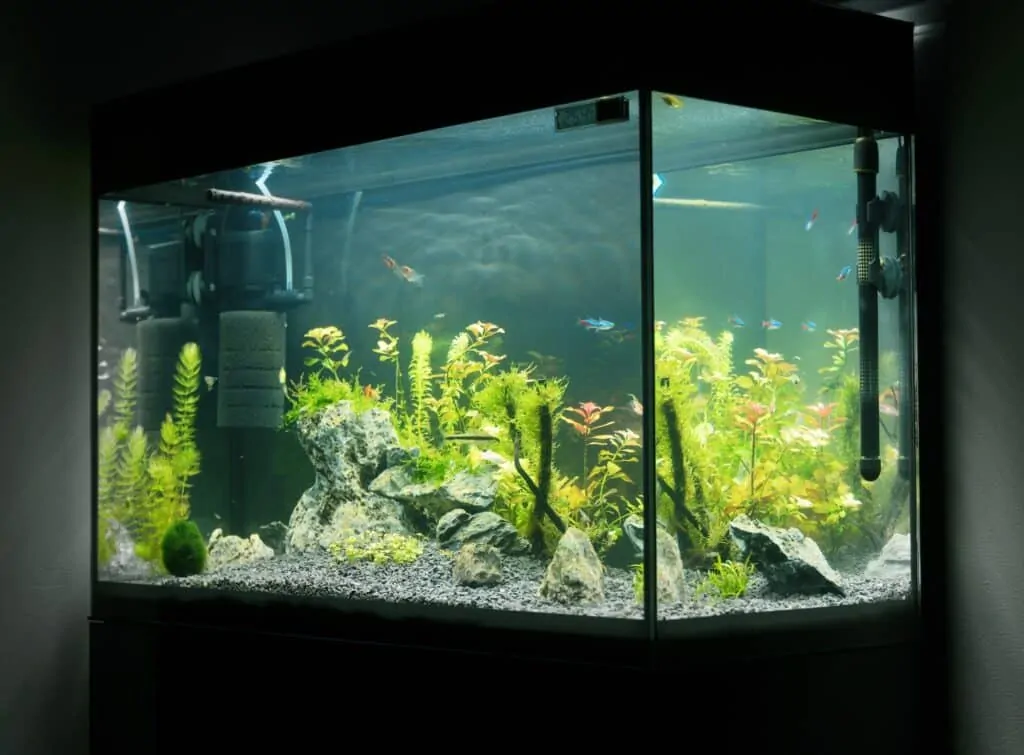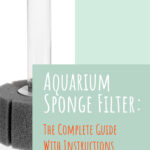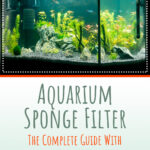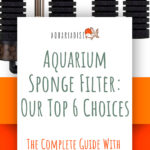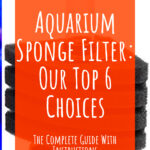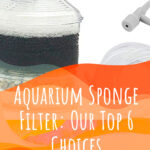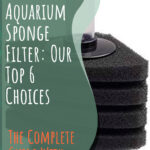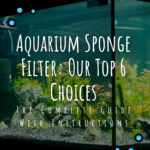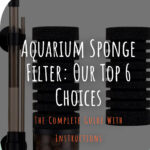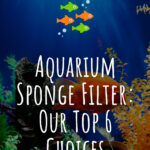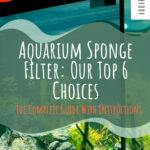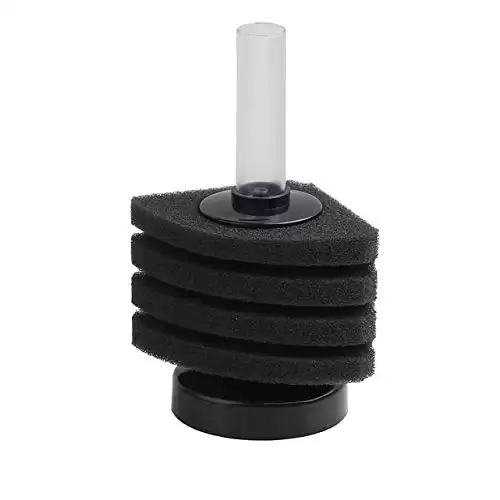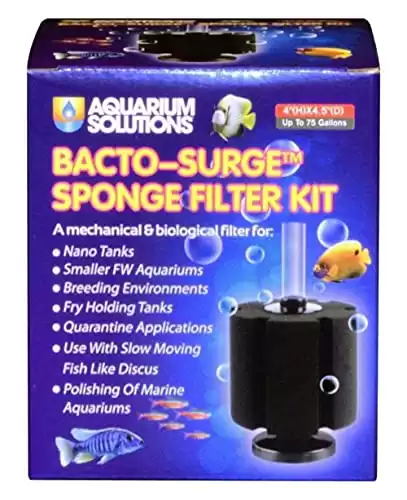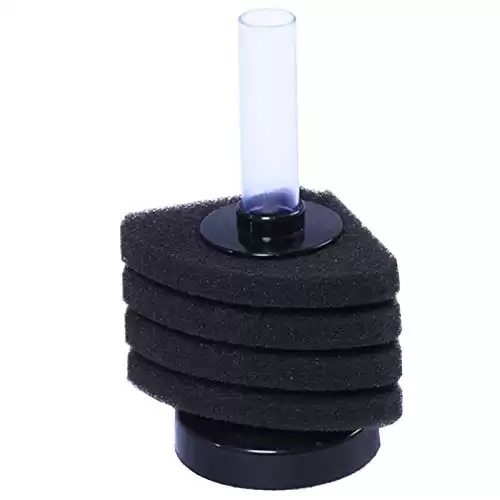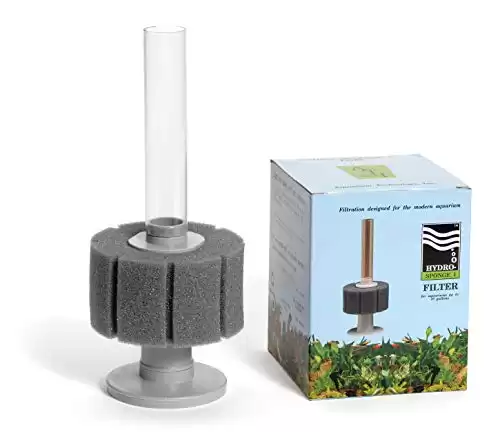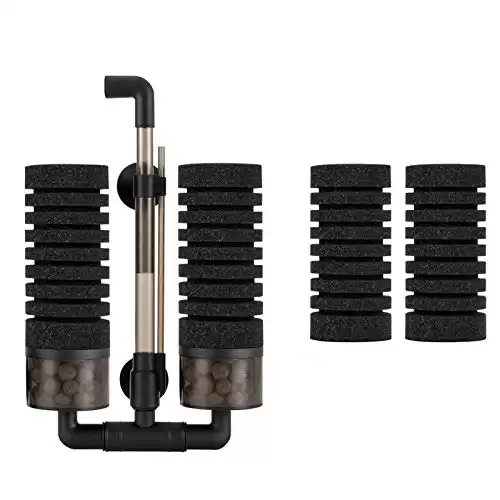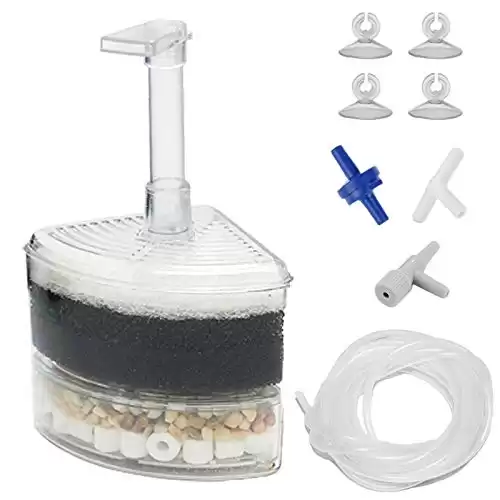While a sponge filter might not be the first type of filtration you think about for your fish tank, a properly sized sponge filter might be the best option. There are many benefits to using a sponge filter instead of a hang on the back filter or a sump tank, like if housing delicate livestock, setting up a quarantine or breeding tank, aerating aquarium water, and if on a tight budget. But with all the flashy aquarium technology available at hand, a sponge filter can be easily overlooked and understated.
Keep reading to find out everything you need to know about aquarium sponge filters, how to use one in your fish tank, and the best 6 aquarium sponge filters for your freshwater or saltwater aquarium!
|
4.6
|
4.5
|
4.6
|
What are sponge filters?
A sponge filter is used to complete biological filtration and some mechanical filtration in the aquarium. Sponge filters may be one of the simplest methods of filtering aquarium water but they are also one of the most effective and cost-effective options as well.
In general, sponge filters are most effective once you have found one that is correctly sized for the tank.
How does a sponge filter work?
Sponge filters work by creating pressure by way of an air pump. Aquarium airline tubing is connected to the air pump piping and the pressure from the air pump forces the water into the sponge and out through the top, filtering and agitating water as it passes through.
Additional aquarium equipment, like an air pump or powerhead, is necessary for creating this pressure. Luckily, these machines can be relatively inexpensive and last for a long time.
Biological filtration
But how do sponge filters actually filter aquarium water?
Actually, sponge filters do very little to help remove the debris and other impurities in aquarium water. If you’re struggling with loose particles regularly floating around in your tank, you will want to look into filter types with more mechanical customizability.
Instead, sponge filters shine in the biological filtration category. As you may already know, beneficial bacteria allows aquatic ecosystems to sustain themselves. Different species of bacteria are responsible for processing ammonia into nitrites and then into nitrates; some bacteria even convert nitrates into nitrogen, which starts the cycle all over again.
In general, most of the ammonia in your tank is the result of fish waste and uneaten food. Without these beneficial bacteria, ammonia levels would be unsustainable for any tropical fish or invertebrate.
When a tank is cycling, this bacteria grows throughout the aquarium, covering every available surface space. A sponge filter increases the amount of surface area available to grow, leading to a better population of beneficial bacteria in your tank and an overall more balanced ecosystem.
Are sponge filters good in the aquarium?
Sponge filters are one of the best filtration options you can get for your aquarium. As we’ll discuss, sponge filters are friendly to delicate livestock, for keeping quarantine/breeding tanks safe and stress-free, for aerating aquarium water, and are overall relatively inexpensive to some other comparable filtration options.
Delicate livestock
If you’ve ever kept shrimp or other tiny fish, you know how easy it is for them to get sucked up into the filter. Too many times, hobbyists purchase popular fish, like neon tetras, that need a very specific aquarium setup in order to do their best. For livestock like this, sometimes the most powerful and highly-rated equipment isn’t the best choice.
With sponge filters, you don’t have to worry about your fish ever getting sucked up. Instead, you will find that many invertebrates actually like to stay near the sponges, which catch tiny debris and detritus that shrimp and snails can easily feed on.
Similarly, many tropical freshwater fish actually prefer calmer water as opposed to tanks with high currents. Sponge filters create enough surface agitation for adequate gas exchange but don’t push livestock around while doing so.
The only concern with sponge filters is having enough surface area within the sponge to house the number of bacteria needed to keep the water safe for those fish and invertebrates; if the sponge is too small for the amount of bioload in the water, then water parameters will spike and cause unideal conditions. Otherwise, a properly-sized sponge filter makes your aquarium safe for all inhabitants!
Quarantine/breeding tank
Likewise, a sponge filter is one of the best options for filtering a quarantine/breeding tank. Often times, these tanks are set up with the bare minimum so that the health of the fish is not compromised. Even more, sponge filters make sure that fish aren’t able to be sucked up or pushed around the tank without needing all the extra space and maintenance that a regular hang on the back filter or canister filter requires.
For the same reasons, sponge filters are usually used in breeding tanks as well. The sponge is usually thick enough to prevent any fry from getting sucked up, and the water flow is low enough to ensure that they are not getting pushed around.
Aerate the water
Not only do sponge filters house beneficial bacteria and catch some detritus, but they also aerate the water. By making bubbles, sponge filters directly add oxygen into the water column. When those bubbles reach the surface, they also create agitation which helps keep algae and biofilm from forming on the surface and also further increases gas exchange.
Well-oxygenated water is important for all fish and invertebrates, especially for those healing from a disease or infection. While hang on the back filters, canister filters, and sump filters also introduce enough oxygen into the system to keep it balanced, they often lack the surface agitation aspect and need additional equipment for circulation.
Inexpensive
Though it is usually ideal to have the best equipment possible for your aquarium setup, it doesn’t necessarily need to be expensive. For the most part, sponge filters cost around 20-30 USD for the initial setup of the actual sponge filter, an air pump, and airline tubing; some kits even include all of these and provide additional valves for further air pressure regulation.
Even more so, sponge filters don’t need to be replaced often, if at all. The only time a sponge should be changed is if/when it starts to deteriorate or if the aquarium air pump starts to fail. Other filtration options require regular floss and media changes, which is an additional cost that needs to be considered upon initial start-up.
A sponge filter can also be an inexpensive solution to combatting power outages. If you’re in an area that often has power outages, some air pumps can be run on batteries. This means that if you have a sponge filter on your tank for filtration, transferring to a battery air pump in the event of an emergency is easy and effortless!
How to clean a sponge filter
The best part about having a sponge filter is the low maintenance and upkeep in comparison to hang on the back filters, canister filters, and sump tanks. When cleaning a sponge filter, all that needs to be rinsed is the actual sponge.
A sponge filter should be removed from the tank and rinsed in another container around every 3-4 weeks depending on the bioload of the tank. If you have a double sponge filter, some hobbyists like to alternate the cleanings of each side in order to preserve as much beneficial bacteria as possible. Because of this, tap water should never be used to clean the sponge filter, as this will affect the bacteria; instead, it is best to use used-tank water that the bacteria are already living in.
Other maintenance
The only other maintenance needed to keep a sponge filter performing its best is to regularly check that the air pump is working as it should; if it starts to make noise, it might not be sitting evenly on the surface or something could be broken inside. It is also important to check airline tubing for any possible clogs or algae growth.
In general, sponge filter foam lasts a considerable amount of time and doesn’t need to be replaced. However, some hobbyists like to change their foams about every once a year to make sure that it doesn’t start disintegrating without them knowing. It is important to have another source of biological filtration in the tank when making these transitions.
Otherwise, as long as the sponge filter is regularly rinsed with tank water, there should be no problems!
The 6 best aquarium sponge filters
At first glance, a lot of aquarium sponge filters will look the same. However, it’s best to go with trusted brands and products that have proven to work for hobbyists with tanks of all shapes and sizes. Below, we have listed 6 of the best aquarium sponges currently available based on efficiency, reliability, design, and price.
Hikari Bacto-Surge High Density Foam Filter, Large
- Works Well For Use In Freshwater Or Marine Applications
- Highly Porous Sponge Maximizes Bacterial Action
- Increased Surface Area Offers Maximum Bacteria Colonization
The Hikari Bacto-Surge High Density Foam Filter is one of the most widely used and appreciated single sponge filters currently in the hobby. Both freshwater and saltwater enthusiasts trust Hikari Bacto-Surge filters to support their aquarium systems with their long-lasting, highly porous sponges. These polyether foam sponges are durable for long-term use while also being easy to clean and rinse out.
This large Hikari Bacto-Surge sponge filter is meant for aquariums up to 75 gallons (283.9 L); other product sizes include mini (up to 10 gallons/37.9 L), small (up to 40 gallons/151.4 L), and x-large (up to 125 gallons/473.2 L). An aquarium air pump is not included.
Customer reviews have found that the sponge filter is difficult to sink and get to stay on the bottom of the tank; it might take several tries to rinse out the sponge in order to expel all the oxygen from the foam. Once in the tank, the Hikari Bacto-Surge sponge filter can seem large at first. Some packages have reportedly come incomplete with missing pieces.
What we like:
- Highly dependable aquarium brand
- Polyether foam for longterm use and easy cleaning
- Efficient water flow for the recommended aquarium size
What could be better:
- Difficulty getting the sponge filter to stay submerged
- Large appearance
- Does not include air pump
- The packaging is sometimes incomplete
Aquarium Technology, Inc. Hydro-Sponge Filter
- Quiet and easy to clean - simply rinse and squeeze in used tank water (not tap water!) to maintain nitrogen-fixing bacteria.
- Hooks up directly to a powerhead or pump, and the diffuser can replace air stones.
The Aquarium Technology, Inc. Hydro-Sponge Filter is a close second favorite for saltwater and freshwater hobbyists. These single sponge filters come in three sizes: up to 10 gallons (37.9 L), up to 20 gallons (75.7 L), up to 40 gallons (151.4 L), up to 80 gallons (302.8 L), and up to 125 gallons (473.2 L). All sizes may be placed horizontally or vertically in the aquarium. An air pump is not included.
This sponge filter has a 1 inch (2.5 cm) diameter lift tube, which allows for a higher volume of water to be processed and for other equipment, like powerheads, to be connected without extra adapters. The sponge is manufactured from Proprietary Patented Sponge Foam for the best mechanical filtration and the most surface area for biological filtration; this material has also been tested to withstand higher water currents and regular cleanings.
Hobbyists have found that the product is often missing necessary pieces when delivered. They also have problems getting this large sponge filter to sink and have had to rinse out the sponge several times in order for it to stay in place at the bottom of the tank. The dense foam also tends to get clogged easily and needs to be cleaned often.
What we like:
- Several sizes for the right fit for your aquarium
- Vertical or horizontal placing
- Larger lift tube for increased customizability
What could be better:
- Aquarium air pump/other necessary equipment for full functionality is not included
- Large sponge tends to float and may clog easily
- The listing title can be misleading and packages come incomplete
hygger Aquarium Double Sponge Filter, Comes with 2 Spare Sponges, 1 Bag of Bio Ceramic Media Balls, Quiet Submersible Foam Filter for Fresh Water and Salt-Water Fish Tank
- ?Filter Demension?plus the sponge filter with media balls takes up no more room.
- ?Package Includes?1 double sponge filter with 2 containers +1 bag of ceramic media balls + 2 pare sponges(packed in the 2 containers).
If you’re looking for a sponge filter with a little more power and customizability, the hygger Aquarium Double Sponge Filter might be worth considering. This sponge filter features two foam intakes that are available in two sizes: Dual S (10-40 gallon/37.9-151.4 L) and Dual M (15-55 gallon/56.8-208.2L); replacement sponges are also easily purchased as well.
Not only does this sponge filter provide mechanical and biological filtration, but there is also a small section underneath the sponge designated for additional biological filtration and/or chemical filtration. One bag of ceramic media balls and two additional sponges are included with the product, though an air pump and the necessary 4 mm airline tubing is not. This ceramic media may be used, or other chemical filtration, like activated carbon (not included), may be substituted instead.
While this sponge filter includes the suction cups needed to secure it to the bottom and side of the aquarium, most reviews have found that the suction doesn’t hold and the sponge ends up floating to the top of the tank. Along with the faulty suction cups, this large sponge filter does not seem to have a long life and seems underpowered for the recommended tank sizes.
What we like:
- Highly customizable in terms of placement and additional media options
- Two-sponge design for more surface area and greater water intake
- Included ceramic media balls for additional biological filtration
What could be better:
- Necessary air pump and airline tubing are not included
- Underpowered for most recommended tank sizes
- Faulty suction cups and short life
Lefunpets Biochemical Sponge Filter Breeding Fry Betta Shrimp Nano Fish Tank for Aquarium Fish Tank 5 Gal-25 Gal
- Perfect for Use-The Tank Corner Sponge filter provides filtration, works great and for longer life.
- Soft Sponge Material-Unique cylindrical shape 6 vertical stripe sponge design, traps floating debris and won't suck up your fish.
If you’re tight on tank space, the corner design of the medium Lefunpets Biochemical Sponge Filter rated for 1-10 gallon (3.8-37.9 L) tanks might be best for your setup; it should be noted that while this sponge filter comes in small for 5-10 gal (18.9-37.9 L), large for 10-25 gal (37.9-94.6 L), and x-large for 30-80 gal (113.6-302.8 L), only the medium for 1-10 gal (3.8-37.9 L) option comes in the corner design.
This grooved sponge filter comes in a convenient corner design for tanks limited in space. All parts are easily disassembled, which makes them easier to clean. However, the necessary air pump is not included and most Lefunpets biochemical sponge filter products perform better with an added air stone.
While the corner sponge filter design is ideal, it is only available in the medium size. Hobbyists have also found that these sponge filters tend to float for a couple of days upon first introducing them to the tank.
The foam sponge is dense which provides ample space for beneficial bacteria to grow but also causes them to clog easily. This sponge filter also tends to be underpowered for the size aquarium recommended; an air stone may be necessary to increase the tank water processing rate.
What we like:
- Corner design for small/limited aquarium spaces
- Several different sponge filter sizes to choose from
- Easy to take apart and clean
What could be better:
- Sponge filter floats for the first several days
- Additional air stone may be needed for adequate filtration
- This sponge filter is usually underpowered for the recommended aquarium size
- Dense foam easily clogs and may need to be rinsed more often
- Air pump not included
Aquaneat Aquarium Bio Sponge Filter Corner Filter Breeding Shrimp Nano Fish Tank Water
- New design: quarter-cylinder shape increases the surface area to get a better water and oxygen exchange rate. It also make the filter easy to hide in the corner of a tank
- Sponge filter provide both mechanical and bio filtration, also, the air infusion chamber produces minute bubbles which increase the oxygen solubility
The Aquaneat Aquarium Bio Sponge Filter is very similar to the Lefunpets Biochemical Sponge Filter but offers the corner design for more aquarium sizes. This sponge filter comes in four sizes: up to 10 Gal (2.25″Lx2.25″Wx5.00″H), Up to 15 Gal (2.25″Lx2.25″Wx6.25″H), Up to 55 Gal (3.50″Lx3.50″Wx9.50-12.00″H), and Up to 90 Gal (4.25″Lx4.25″Wx11.50″-13.50″H).
This sponge filter is a favorite for many saltwater and freshwater hobbyists alike. The grooved corner design helps increase surface area for beneficial bacteria and can easily be hidden behind plants or other decorations.
Unlike most other sponge filter products, the Aquaneat Aquarium Bio Sponge Filter tends to settle very quickly at the bottom of the tank and does not float when first introduced. This sponge filter also produces notably larger bubbles than other competitors, which can increase the oxygen levels in the tank but may also upset more delicate livestock.
Still, this sponge filter seems to be slightly underpowered for the recommended aquarium sizes, and it may be better to go with multiple sponge filters or a larger one altogether.
What we like:
- Corner design for several aquarium sizes
- Grooved sponge foam for additional surface area for beneficial bacteria
- Tends to submerge and stay submerged quickly
What could be better:
- This sponge filter produces larger bubbles, which can affect smaller and more delicate livestock
- Generally underpowered sponge filter for the recommended tank sizes
- Some pieces reported missing from the original packaging
AQUANEAT Aquarium Air Driven Bio Corner Filter Sponge for Fry Shrimp Nano Fish Tank with Airline Tubing, Air Pump Valves, Suction Cups
- Corner filter provide both mechanical and bio filtration, and supplying the water with much needed oxygen ,reduces noise from air pump and consumes lowest wattage
- Easy to set up & clean: simply install an airline into the unit and turn on the air pump, also, multi-layers design is easy to clean, simply rinse and squeeze sponge in tank water
If you love the space-saving aspect of the corner design and want the ability to use chemical filtration, then the AQUANEAT Aquarium Air Driven Bio Corner Filter Sponge will work best in your tank. This sponge filter comes in two sizes: small up to 20 Gal (75.7 L) and large up to 40 Gal (151.4 L). Each option includes one sponge filter, a 4 foot (121.9 cm) long airline tubing, four suction cups, one control valve, one tee, and one non-return check valve; an air pump is not included.
This corner sponge filter is designed to perform mechanical, biological, and chemical filtration while also keeping the aquarium water fully aerated. The sponge filter is set up into different compartments, with room for the foam filter media and for other filter media of choice for completing chemical filtration.
Reviews have found the plastic material to be cheap, which can easily cause the item to come broken in the packaging or to break if hit in the tank; this plastic is also clear, which can result in algae growth on the inside if not regularly maintained. Some packaging does not include instructions, which can make assembling the sponge filter difficult; even more so, the setup displayed on the box is usually incorrect.
What we like:
- Almost fully customizable sponge filter corner design
- Designed for mechanical, biological, and chemical filtration
- Includes additional sponge filter accessories
What could be better:
- Clear plastic design is cheap and can let algae grow
- Exterior plastic instead of foam filter sponge also lessens the surface area for beneficial bacteria
- More difficult assembly
- Does not include an air pump
FAQ
These are some common questions you’ll likely ask yourself if you’re considering buying a sponge filter or if you’re entirely new to running a sponge filter in your own aquarium!
Can you use a regular sponge as an aquarium filter?
If you’re thinking about using a kitchen sponge as a substitute for your sponge filter, you might want to think again.
Kitchen sponges are very thick and don’t allow enough water to flow through in order to be fully effective at cleaning the tank water of debris and creating an optimal space for beneficial bacteria to grow. It can also be difficult to tell if your kitchen sponge has been treated with chemicals for more effective cleaning.
Most times, these chemicals will prove to be deadly to fish and other invertebrates if placed in the tank. Kitchen sponges that are made of cellulose will also start to breakdown in the aquarium, causing a mess to clean up and a deadly situation for your livestock.
Instead, it is best to just use an aquarium-safe filter sponge or other floss/foam filter. This material has been designed to let the most water flow through while creating an optimal space for beneficial bacteria to grow.
How can you make your sponge filter quieter?
Sponge filters can get loud between the air pump and the bubbles. Luckily, many hobbyists have come up with easy and effective methods for lessening the noise coming from the sponge filter.
Put a lid on the aquarium
This might seem like a simple idea, but if you don’t have a lid on your aquarium and don’t have a particular preference between rimless tanks and tanks with rims, then you may as well put a lid on it! An aquarium lid should help keep most of the sound from escaping, and it’s a good first step for a quieter filtration system; this hack also cuts down on the amount of evaporation dramatically!
Make sure the air pump is on a mat
This might seem like another simple fix, but making sure that the air pump is sitting on padding of some sort will help lessen the vibration noises and also help keep the air pump in place, ultimately making the sponge filter more secure in the tank. Some sponge filters might even come with a placemat, otherwise, fabric or a computer mouse pad may also work as long as it lays flat.
Aquarium valves
Sometimes air pumps come with various valves and nozzles that are meant for further control over the air stream and pressure; if yours didn’t come with one, don’t worry, they’re relatively inexpensive and easy to find at most aquarium or pet stores. These valves can ultimately help control the number of bubbles produced in the tank and therefore, lower the noise. Keep in find that a decreased stream of air will also result in the sponge filter pulling in and filtering less water.
Modify the airline tubing/sponge filter
We don’t recommend trying to modify your airline tubing or sponge filter unit unless you have a backup and are willing to make a mistake. Some hobbyists have been able to connect air stones within their sponge filters to diffuse the amount of air pressure. Others attach their sponge filters to powerheads in order to eliminate the noise from bubbles entirely as this method works by creating water pressure instead of air pressure; this is also a good method if you’re limited on space around the aquarium as the powerhead will sit submerged in the tank.
Lastly, there are ways to modify airline tubing and the mechanics of air pumps, but this is largely achieved through trial and error.
Buy new equipment/switch to another brand
If you’ve tried to modify your air pump or sponge filter as best you can and you still can’t stand the noise level, then it might be time to consider buying new equipment or switching to a new brand entirely.
It is possible that your air pump/sponge filter also broke, leading it to make even more extra noise. Unfortunately, there isn’t a way to test out exactly how loud a different air pump or sponge filter might be before putting it in your tank, but there’s likely to be a slight improvement if you go with more aquarium-specific brands.
How do you make a sponge fish tank filter?
An aquarium sponge filter is a relatively inexpensive and widely accessible piece of equipment. But if you’re one of those people who like to completely DIY your tanks, then you might be wondering how you can assemble your own sponge filter. First, we need to understand the parts that make up a commercial sponge filter.
Foam filter sponge(s)
The foam filter sponge is what makes sponge filtration work; it’s where debris is filtered out and, more importantly, where beneficial bacteria is housed. It’s important to get an aquarium-safe sponge that is dense for the most surface area, but permeable enough to allow water to freely flow through.
This foam filter sponge is graded on a scale of pores per inch (PPI). In general, 10-30 PPI is ideal; lower PPI will have larger pores, and higher PPI will have smaller pores.
Base
A sponge filter base is designed with two purposes in mind. One is to weigh down the sponge filter unit, and the other is to lift the filter sponge off of the substrate so that water is equally pulled in from all directions.
Some sponge filter bases are not weighted, and instead, the manufacturer will include suction cups. In most situations, it doesn’t hurt to have both a weighted base and suction cups as new sponge filters tend to float for the first couple of days.
Lift tube
The lift tube is used to direct air/water when it is leaving the sponge filter. The lift tube is usually made of plastic and creates a tube to feed the airline tubing into the sponge filter; it also helps direct air and water back out into the tank. A lift tube is also sometimes used for connecting powerheads.
Bulls eye and strainers
The bulls eye is simply for creating an easier attachment point for airline tubing; some sponge filter products include a bulls eye and others do not.
Strainers are used to further catch detritus and debris, as well as any small fish or invertebrates that could’ve possibly gotten sucked up.
Building your own sponge filter
In order to build your own sponge filter, you will still need pieces that perform the same functions as the items listed above, but in a more creative way. With this method, an air pump, airline tubing, and an air stone are still required.
Once you have an aquarium-safe foam filter sponge, you will need to cut a hole in the center. You will then need to create a base for the sponge so that it is weighed down; some hobbyists use ceramic tiles or glass since they are naturally heavy, but make sure that whatever you’re using has been treated for aquarium use.
In order to create a strainer, you can use a drilled PVC pipe that has an end cap on one side and 90° elbow on the other side; the drilled area should only be where the sponge provides full coverage. The 90° elbow will also need to be drilled directly down the center in order to feed the airline tubing.
An air stone needs to be connected to the airline tubing and air pump and fed through the PVC pipe. Once this has been done, the sponge can be put on the PVC and the end cap can be superglued or siliconed to the base.
Conclusion
While you might think that you need the best aquarium technology currently available to make your fish tank thrive, sometimes the simplest filtration system can be the most effective. While a hang on the back filter, canister filter, or sump tank might allow for greater customizability in terms of installable media, a sponge filter harbors the beneficial bacteria needed to keep an aquarium going.
There are many different sponge filter products currently available. It is most important to understand the right-sized sponge that your fish tank needs so that enough surface area is allotted to bacteria; it is also important to consider if your tank would do best with a single or double sponge filter and if you would like a compartment for installing filter media. Even if none of them seem to fit all your aquarium needs, then it’s possible to even create your own sponge filter out of a few household items!
If you have any questions about how sponge filters work, if one will work in your aquarium, or if you have had experience with a certain type of sponge filter, don’t hesitate to leave a comment below!
- https://www.amazon.com/Hikari-Bacto-Surge-Density-Filter-Large/dp/B00GOFPX9I/ref=sr_1_4?dchild=1&keywords=hikari+sponge+filter&qid=1605045492&s=pet-supplies&sr=1-4
- https://www.amazon.com/Filter-Max-III-Prefilter-Aquariums-Gallons/dp/B000255OZ4/ref=sr_1_4?dchild=1&keywords=Aquarium+Technology%2C+Inc.+Hydro-Sponge+Filter&qid=1605154615&sr=8-4
- https://www.amazon.com/Hygger-Aquarium-Sponges-Submersible-Salt-Water/dp/B07RKT6QPV/ref=sr_1_4?dchild=1&keywords=hygger+Aquarium+Double+Sponge+Filter&qid=1605156924&s=pet-supplies&sr=1-4
- https://www.amazon.com/Lefunpets-Biochemical-Sponge-Breeding-Aquarium/dp/B0816W73LD/ref=sr_1_5?dchild=1&keywords=corner+sponge+filter&qid=1605050671&sr=8-5
- https://www.amazon.com/Aquaneat-Aquarium-Sponge-Filter-Breeding/dp/B078X7H8XG/ref=sr_1_9?dchild=1&keywords=corner%2Bsponge%2Bfilter&qid=1605051060&sr=8-9&th=1
- https://www.amazon.com/Aquaneat-Aquarium-Driven-Corner-Accessories/dp/B079M732S6/ref=psdc_2975472011_t3_B078X7H8XG

